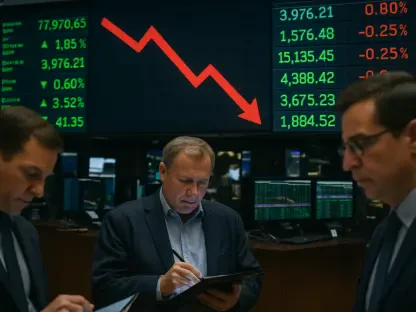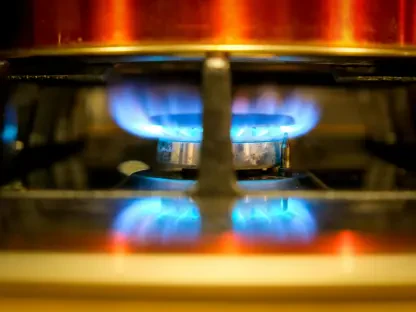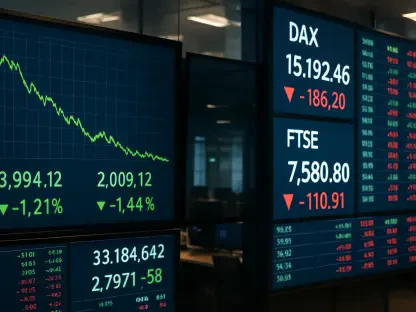In a stunning turn of events that has captivated the financial world, silver has skyrocketed to unprecedented heights, shattering price records and igniting a powerful rally across the precious metals sector, marking a significant shift in global market dynamics. On November 13, the COMEX December silver contract peaked at an astonishing $54.42 per ounce, while spot silver trailed closely at $54.49, reflecting a remarkable 74% year-to-date increase. This surge is not merely a statistical anomaly but a profound signal of changing dynamics in global markets, where silver stands tall as a leader among commodities. Unlike other resources like crude oil, which are grappling with declines, silver’s meteoric rise alongside gold underscores a unique and selective strength in precious metals. This phenomenon is driven by a confluence of industrial needs and economic uncertainties, painting a complex picture of opportunity and challenge. As this rally unfolds, it prompts critical questions about the future of commodities and their role in both technology and finance. This exploration delves into the forces propelling silver to these dizzying heights, examines its broader implications for industries and investors, and considers what this historic moment means for the global economic landscape. The journey through this market shift reveals not just numbers, but a deeper story of transformation.
Unprecedented Heights in Silver Pricing
Silver’s climb to over $54 per ounce on November 13 marks a historic milestone that has redefined expectations within the commodity sphere. This extraordinary ascent, characterized by a 21% gain in just the past 30 days and an 11% spike in a mere five days, showcases a momentum that has broken through a decade-long period of stagnation. Far from a temporary blip, this performance positions silver as a dominant force in the precious metals market, outstripping historical benchmarks and capturing the attention of analysts worldwide. The sheer scale of this rally reflects underlying currents that go beyond surface-level speculation, pointing to a fundamental revaluation of silver’s worth in today’s economy. Investors are now recalibrating their strategies to account for this unexpected yet robust upward trajectory, which shows no immediate signs of slowing down.
The significance of silver’s record-breaking run extends into broader market psychology, signaling a shift in how commodities are perceived in times of uncertainty. Unlike past surges driven largely by speculative fervor, the current rally appears rooted in tangible demand and structural constraints, setting it apart as a potentially sustainable trend. This remarkable performance has not only elevated silver’s status but also sparked renewed interest in the entire precious metals sector, encouraging a closer examination of what fuels such dramatic price movements. As silver continues to lead, it sets a precedent for how other metals might be valued, urging stakeholders to rethink traditional investment approaches in light of these evolving market conditions.
The Dual Powerhouse Behind Silver’s Rise
At the heart of silver’s extraordinary rally lies its unique dual role as both an industrial necessity and a financial safe haven, a combination that amplifies its appeal in today’s volatile environment. Industrially, silver is indispensable, playing a critical role in high-demand sectors such as electronics, solar panel production, battery technology, and the burgeoning infrastructure for artificial intelligence data centers. This insatiable need from cutting-edge industries has driven demand to levels that supply struggles to match, creating a powerful upward pressure on prices. Meanwhile, silver’s status as a reliable asset during economic turbulence adds another layer of attraction for investors seeking stability amidst a weakening U.S. dollar and anticipated Federal Reserve rate adjustments. This blend of practical and protective value makes silver a standout commodity in a crowded field.
Beyond its immediate applications, silver’s dual identity reflects broader trends in how resources are valued in the modern era, where technological advancement and financial security often intersect. The industrial boom, particularly in renewable energy and digital innovation, underscores silver’s critical place in shaping future economies, while its safe-haven allure mirrors gold’s traditional role as a hedge against inflation and geopolitical unrest. This convergence of purposes sets silver apart from commodities tied solely to one dimension, offering a resilience that few others can match. As markets grapple with uncertainty, silver’s ability to serve multiple needs ensures its rally is not just a fleeting moment but a reflection of deeper, structural shifts that could redefine its place in global trade for years to come.
Supply Challenges and Escalating Demand
One of the most significant catalysts behind silver’s price surge is the persistent mismatch between supply and demand, a gap that continues to widen with each passing day. Global mine production has failed to keep pace with the soaring needs of industries reliant on silver, resulting in dwindling inventories at key trading hubs like London’s LBMA and stagnant deliverable stocks at COMEX warehouses. This scarcity creates a bottleneck that naturally drives prices upward, as buyers scramble to secure limited resources. The supply constraints are not merely a short-term hiccup but a chronic issue, rooted in the challenges of scaling mining operations amidst environmental and regulatory hurdles, further intensifying the market’s tightness.
Compounding these supply woes is an unprecedented wave of physical demand, particularly evident in key markets such as India, where the Diwali festival season has seen purchases of silver bars and coins double compared to previous benchmarks. This cultural and economic appetite for tangible silver adds significant pressure to an already strained supply chain, pushing prices to new heights as retailers and investors alike vie for physical stock. Unlike speculative trading, this demand is grounded in real-world usage and tradition, making it a formidable force in the market. As physical buying continues to surge alongside industrial needs, the strain on silver reserves highlights a critical imbalance that could sustain elevated prices, prompting questions about how long current production levels can hold before more drastic measures are needed.
Gold’s Complementary Strength in the Rally
While silver commands much of the spotlight with its record-shattering performance, gold is not far behind, reinforcing the bullish trend across precious metals with its own impressive gains. Trading above $4,100 per ounce and approaching a peak of $4,400 seen in October, gold boasts a year-to-date increase of over 50%, driven by factors that echo silver’s appeal as a safe-haven asset. Central bank acquisitions, persistent geopolitical tensions, and concerns over inflation have bolstered gold’s position as a trusted store of value, attracting a wide range of investors seeking to diversify their portfolios. This parallel strength underscores a broader confidence in precious metals as reliable anchors in uncertain times.
Although gold lacks the industrial heft that gives silver an additional edge, its enduring role as a financial bulwark complements the ongoing rally, creating a synergistic effect within the sector. The consistent demand from sovereign entities and institutional players, particularly in regions like Russia and India, further solidifies gold’s upward trajectory, mirroring silver’s resilience in the face of economic headwinds. This combined momentum suggests that precious metals as a whole are entering a phase of renewed relevance, distinct from other commodity classes. As gold continues to perform alongside silver, it reinforces the narrative of a selective rally, one that prioritizes metals with intrinsic and strategic value over more volatile or oversupplied resources, shaping a new hierarchy in global markets.
Diverging Fortunes in the Commodity Landscape
In stark contrast to the soaring heights of precious metals, energy commodities like crude oil are experiencing a significant downturn, highlighting a fragmented and selective rally in today’s market. On November 13, WTI crude oil futures plummeted over 4% to $58.42 per barrel, with Brent crude not faring much better at $63.14, driven by fears of oversupply and swelling U.S. inventories. This decline stands in sharp opposition to the bullish trends in silver and gold, revealing a breakdown in traditional correlations where commodities typically move in tandem. The disparity underscores how unique drivers, rather than broad economic cycles, are shaping the current landscape, with precious metals carving out a distinct path of strength.
This divergence prompts a reevaluation of how commodities are interconnected, as the factors propelling silver and gold—industrial demand and safe-haven buying—bear little resemblance to the challenges facing oil, such as production surpluses and weakening global demand. The split trajectory serves as a reminder that not all resources are benefiting from the same tailwinds, and investors must adopt a more nuanced approach to navigate this uneven terrain. As energy markets struggle, the spotlight on precious metals intensifies, suggesting that their rally is not just a reaction to economic conditions but a reflection of specific, structural advantages. This contrast could redefine commodity investment strategies, pushing focus toward metals that offer both practical utility and financial security in an increasingly unpredictable world.
Economic Ripples Across Industries
The dramatic rise in silver prices sends ripples through various sectors, creating clear winners and losers in a market reshaped by this historic rally. Mining companies such as Pan American Silver Corp. and Fresnillo PLC are among the primary beneficiaries, enjoying substantial revenue boosts and rising stock valuations as silver’s value climbs. Gold miners like Barrick Gold Corporation and Newmont Corporation also capitalize on the precious metals surge, seeing their operations gain newfound profitability. This windfall for the mining sector highlights how commodity booms can directly translate into corporate gains, fueling optimism among shareholders and potentially spurring further investment in exploration and production.
Conversely, industries heavily reliant on silver as a raw material face mounting challenges due to escalating costs that threaten profit margins. Solar panel manufacturers like First Solar, Inc., electronics producers such as Apple Inc., and automotive companies including Tesla, Inc., are grappling with the financial strain of higher input expenses, which could lead to increased prices for consumers or squeezed profitability. Meanwhile, the downturn in crude oil prices hits oil and gas giants like Exxon Mobil and Chevron hard, compounding the uneven impact across sectors. This disparity illustrates the complex downstream effects of commodity price shifts, where a boon for one industry often spells trouble for another, forcing businesses to adapt swiftly to maintain competitiveness in a rapidly changing economic environment.
Shaping the Future of Precious Metals
Looking ahead, the sustained momentum of silver and gold points to a potentially transformative era for precious metals, driven by structural demand and persistent supply imbalances that show little sign of abating. The critical role of silver in advancing technologies, from renewable energy to artificial intelligence infrastructure, coupled with its safe-haven status, suggests that elevated prices could become a new norm rather than a temporary peak. However, risks such as short-term profit-taking or unexpected shifts in monetary policy, including potential Federal Reserve tightening, introduce elements of volatility that stakeholders must monitor closely. The outlook remains cautiously optimistic, with metals poised to maintain their prominence in investment portfolios and industrial applications.
Reflecting on this historic rally, the events of November 13 stood as a pivotal moment when silver breached the $54 per ounce barrier, leading a charge that redefined the commodity landscape. Gold’s parallel climb above $4,100 per ounce further cemented the strength of precious metals against the backdrop of declining crude oil prices around $58 per barrel. As industries adjusted to these shifts, mining firms celebrated gains while manufacturers braced for cost pressures. Moving forward, the focus should shift to strategic actions—policymakers might consider securing domestic metal supplies, while investors could explore diversified holdings to mitigate risks. The enduring lesson from this period is the need for adaptability, ensuring that both industries and markets are prepared for the evolving role of precious metals in a technology-driven, uncertainty-laden world.









